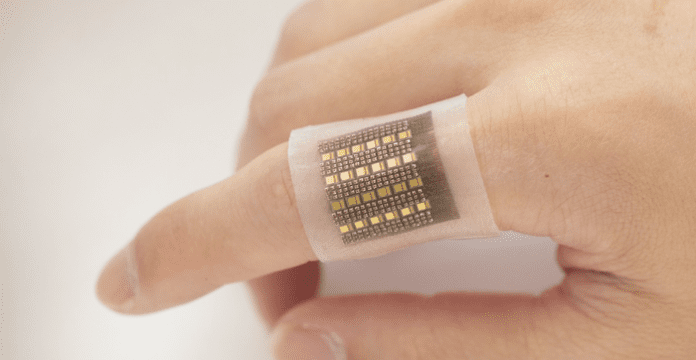
A team of engineers have designed a wearable skin patch using a photoacoustic sensor to help clinicians monitor haemoglobin levels.
Engineers from the University of California San Diego, have developed a wearable skin patch that monitors biomolecules in deep tissues, including haemoglobin. This gives medical professionals access to information that could help identify life-threatening conditions such as malignant tumours, organ dysfunction, cerebral or gut haemorrhages and more.
“The amount and location of haemoglobin in the body provide critical information about blood perfusion or accumulation in specific locations. Our device shows great potential in close monitoring of high-risk groups, enabling timely interventions at urgent moments,” said Sheng Xu, a professor of nanoengineering at UC San Diego and corresponding author of the study.
The paper was published in Nature Communications.
Continuous monitoring for common conditions
Continuous monitoring using a wearable skin patch, for example, can aid in the diagnosis of conditions that cause low blood perfusion. Low blood perfusion can cause severe organ dysfunctions and is associated with heart attacks and vascular diseases.
The new wearable skin patch overcomes some significant limitations noted in existing methods of monitoring biomolecules. Magnetic resonance imaging (MRI) and X-ray-computed tomography both use bulky equipment that is located in healthcare facilities, and they usually only provide information on the status of the molecule, making them unsuitable for long-term biomolecule monitoring.
“Continuous monitoring is critical for timely interventions to prevent life-threatening conditions from worsening quickly,” said Xiangjun Chen, a nanoengineering PhD student in the Xu group and study co-author. “Wearable devices based on electrochemistry for biomolecule detection, not limited to haemoglobin, are good candidates for long-term wearable monitoring applications. However, the existing technologies only achieve the ability of skin-surface detection.”
The wearable skin patch is flexible and non-invasive
The flexible, low-form-factor wearable skin patch attaches to the skin, allowing for non-invasive long-term monitoring. It can perform three-dimensional mapping of haemoglobin with a submillimetre spatial resolution in deep tissues, down to centimetres below the skin, versus other wearable electrochemical devices that only sense the biomolecules on the skin surface. It can achieve high contrast to other tissues. Furthermore, its optical sensor means that the wearable skin patch can expand the range of detectable molecules, integrating different laser diodes with different wavelengths, along with its potential clinical applications.
The wearable skin patch has laser diodes and piezoelectric transducers in its soft silicone polymer matrix. The laser diodes emit pulsed lasers into the tissues. Then, the biomolecules in the tissue absorb the optical energy and radiate acoustic waves into surrounding media.
“Piezoelectric transducers receive the acoustic waves, which are processed in an electrical system to reconstruct the spatial mapping of the wave-emitting biomolecules”, said Xiaoxiang Gao, a postdoctoral researcher in Xu’s lab and co-author of the study.
“With its low-power laser pulses, it is also much safer than X-ray techniques that have ionising radiation”, said Hongjie Hu, a postdoctoral researcher in the Xu group and study co-author.
























